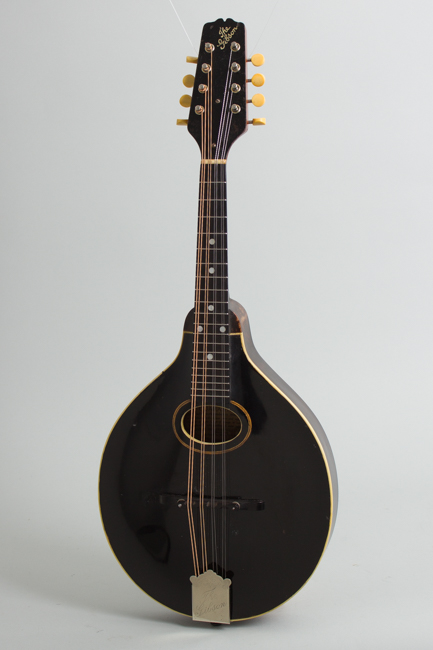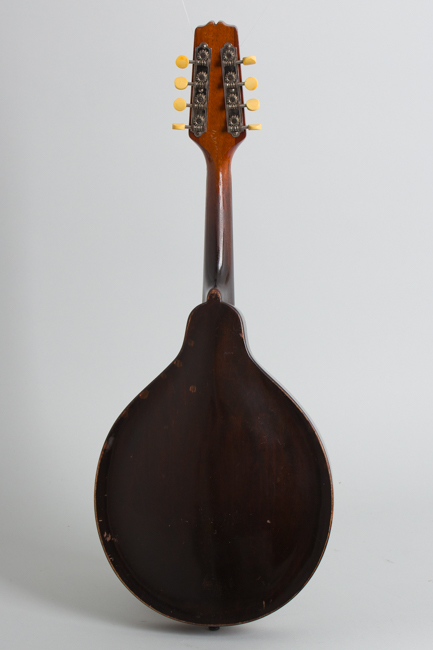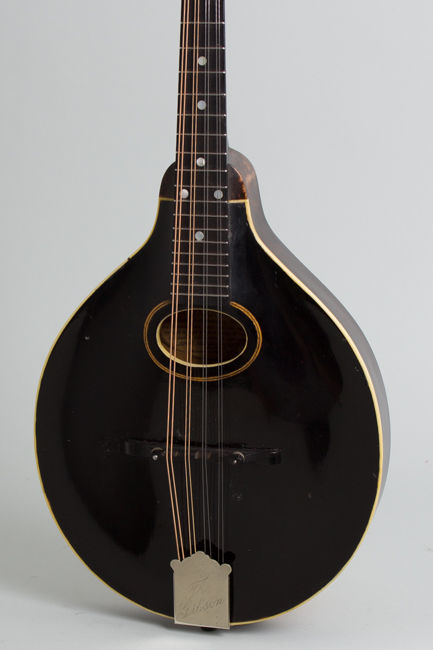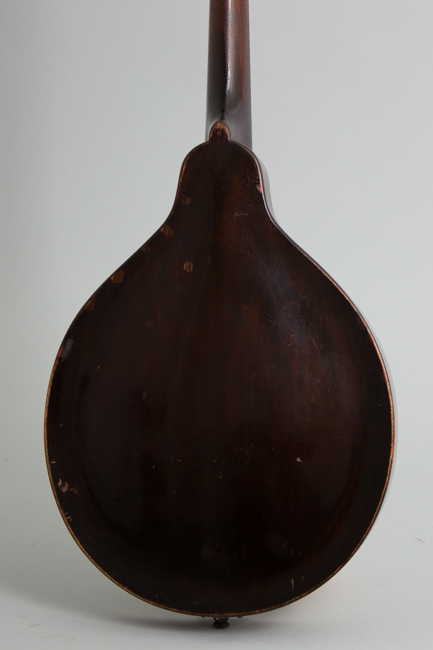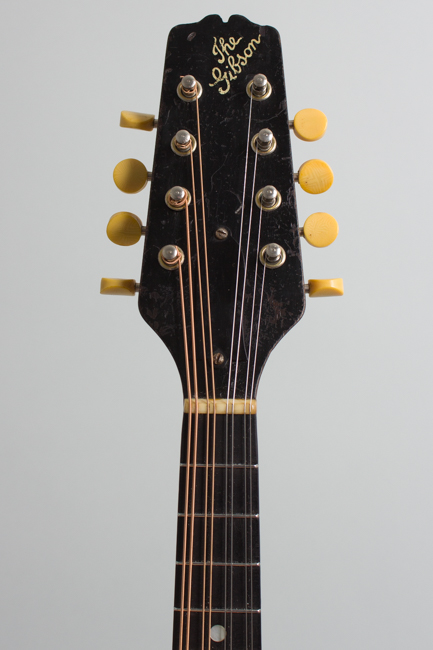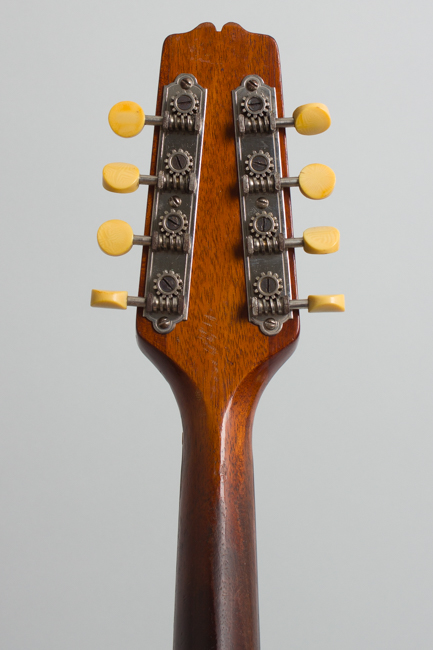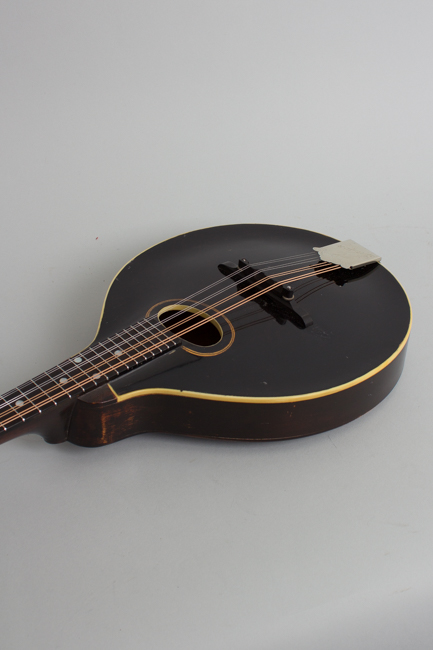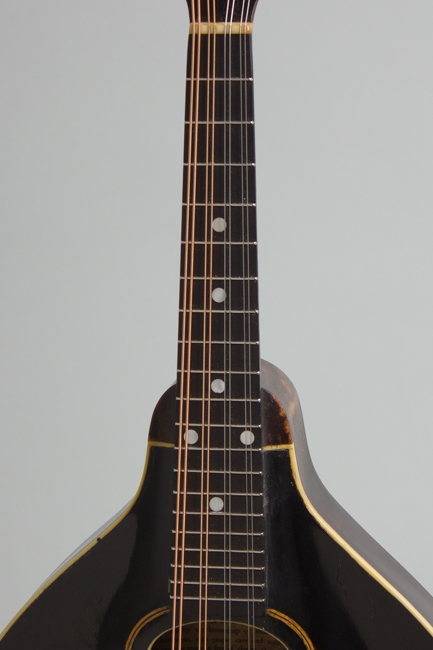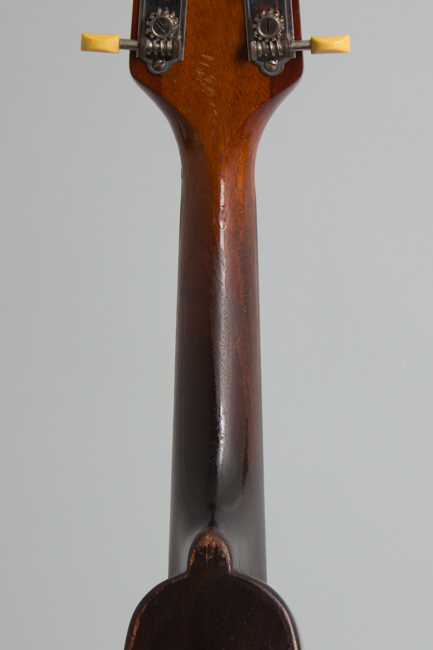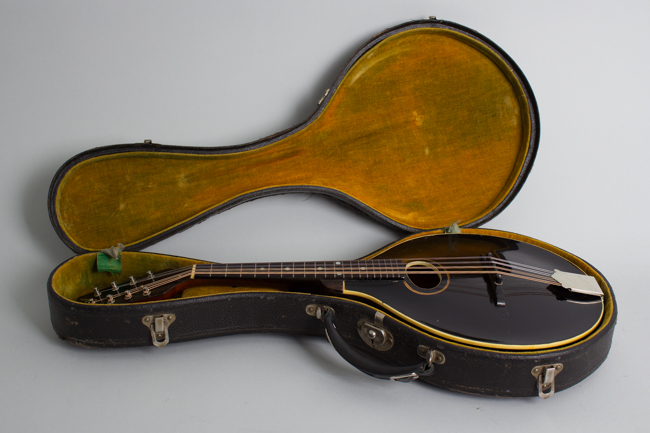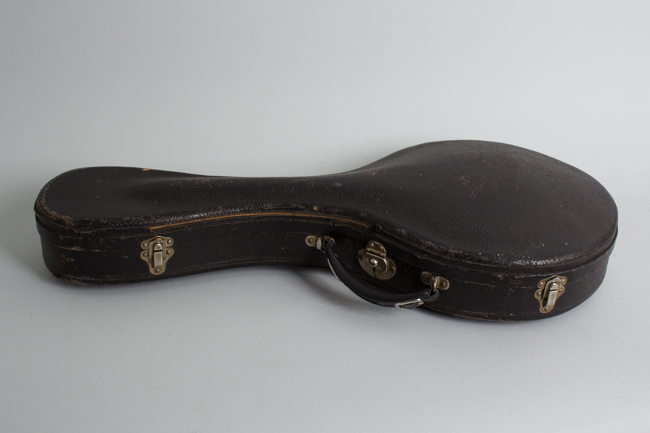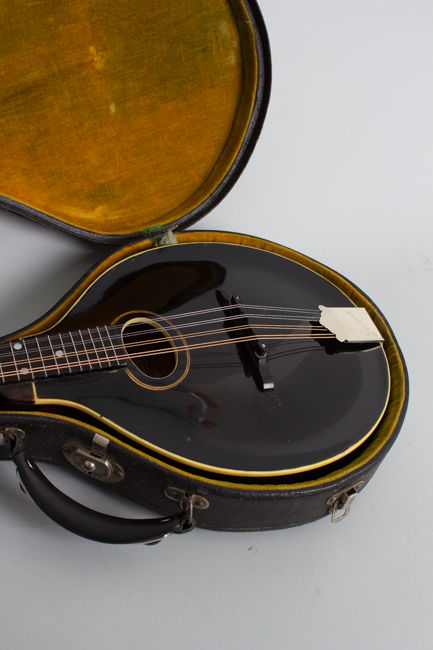Gibson Style A Snakehead Carved Top Mandolin (1925)
Gibson Style A Snakehead Model Carved Top Mandolin (1925), made in Kalamazoo, Michigan, serial # 78701, black top, dark stained back and sides finish, birch back and sides, spruce top, mahogany neck with ebony fingerboard, original black hard shell case.
This is a good playing and sounding, "player grade" Style A mandolin from mid-1925, just at the end of the "Loar era" at Gibson. It has had some old finish work done but retains the excellent sound these "Snakeheads" are known for. Gibson's mandolin craftsmanship in this era produced what many consider the best-sounding roundhole A style mandolins ever made, just before the company's focus shifted to banjos and then guitars.
These "Snakehead" instruments are named for their Loar-designed peghead that angles inward towards the tip, a very logical design feature inexplicably abandoned by Gibson a couple of years after he left the company. They are revered for their unmatched tone and projection and have other advanced features of the era including the adjustable truss rod neck, raised adjustable bridge and very slim neck profile. The top on this A bears a striking black lacquer finish, bound in white celluloid with a thin double inlaid wood soundhole ring. The tailpiece has the engraved "The Gibson" cover plate and the tuners are strips with plain ends. The stenciled silver script "The Gibson" logo on the headstock is specific to this period.
Lloyd Loar's tenure as acoustic engineer at Gibson has become so mythical that sometimes separating fact from fiction is difficult. Certainly the mandolin family instruments made during the period of his employment are the most perfectly realized in Gibson's history, and have become the template for most similar instruments since. The Master Model Style 5 line with their violin-style F-holes was his greatest contribution but all Gibson mandolins were refined at the same time. Even this basic "A" model has noticeable sonic and playing improvements benefitting from "Master Loar's" input that are still evident today, nearly 100 years on.
Overall length is 25 3/4 in. (65.4 cm.), 10 in. (25.4 cm.) wide, and 1 7/8 in. (4.8 cm.) in depth, measured at side of rim. Scale length is 14 in. (356 mm.). Width of nut is 1 1/16 in. (27 mm.).
This is a good playing and sounding "snakehead" but is has had an eventful life so far and is not completely original. The back, sides and especially the top were overfinished long ago, and show a decent amount of wear accumulated since. The top has several patched screw holes, probably from a pickup installation of some sort; they are not conspicuous from the outside but can be seen internally. The face has a heavier coat of added black lacquer and clearcoat (the back and sides are only thinly overfinished) with some additional patching visible around the bridge. There may have been some wood chipping above the bridge foot, but no damage is visible internally.
Overall the finish shows dings, scrapes and dents with some random larger spots worn through on the back by the edge below the neck heel. The finish on the headstock and back of the neck remains original showing some noticeable wear, with areas down to the wood on the neck and numerous dings and chips to the headstock.
All seams are solid (some wear likely reglued long ago) and there are no visible crack repairs. The tuners, tailpiece and cover, and bridge appear original, the pickguard is long gone. The fingerboard has been trued and refretted with appropriate wire and this mandolin plays great with a bright and singing sound. It still resides in its original HSC, worn but solid with a modern handle. Overall Very Good Condition.
This is a good playing and sounding, "player grade" Style A mandolin from mid-1925, just at the end of the "Loar era" at Gibson. It has had some old finish work done but retains the excellent sound these "Snakeheads" are known for. Gibson's mandolin craftsmanship in this era produced what many consider the best-sounding roundhole A style mandolins ever made, just before the company's focus shifted to banjos and then guitars.
These "Snakehead" instruments are named for their Loar-designed peghead that angles inward towards the tip, a very logical design feature inexplicably abandoned by Gibson a couple of years after he left the company. They are revered for their unmatched tone and projection and have other advanced features of the era including the adjustable truss rod neck, raised adjustable bridge and very slim neck profile. The top on this A bears a striking black lacquer finish, bound in white celluloid with a thin double inlaid wood soundhole ring. The tailpiece has the engraved "The Gibson" cover plate and the tuners are strips with plain ends. The stenciled silver script "The Gibson" logo on the headstock is specific to this period.
Lloyd Loar's tenure as acoustic engineer at Gibson has become so mythical that sometimes separating fact from fiction is difficult. Certainly the mandolin family instruments made during the period of his employment are the most perfectly realized in Gibson's history, and have become the template for most similar instruments since. The Master Model Style 5 line with their violin-style F-holes was his greatest contribution but all Gibson mandolins were refined at the same time. Even this basic "A" model has noticeable sonic and playing improvements benefitting from "Master Loar's" input that are still evident today, nearly 100 years on.
Overall length is 25 3/4 in. (65.4 cm.), 10 in. (25.4 cm.) wide, and 1 7/8 in. (4.8 cm.) in depth, measured at side of rim. Scale length is 14 in. (356 mm.). Width of nut is 1 1/16 in. (27 mm.).
This is a good playing and sounding "snakehead" but is has had an eventful life so far and is not completely original. The back, sides and especially the top were overfinished long ago, and show a decent amount of wear accumulated since. The top has several patched screw holes, probably from a pickup installation of some sort; they are not conspicuous from the outside but can be seen internally. The face has a heavier coat of added black lacquer and clearcoat (the back and sides are only thinly overfinished) with some additional patching visible around the bridge. There may have been some wood chipping above the bridge foot, but no damage is visible internally.
Overall the finish shows dings, scrapes and dents with some random larger spots worn through on the back by the edge below the neck heel. The finish on the headstock and back of the neck remains original showing some noticeable wear, with areas down to the wood on the neck and numerous dings and chips to the headstock.
All seams are solid (some wear likely reglued long ago) and there are no visible crack repairs. The tuners, tailpiece and cover, and bridge appear original, the pickguard is long gone. The fingerboard has been trued and refretted with appropriate wire and this mandolin plays great with a bright and singing sound. It still resides in its original HSC, worn but solid with a modern handle. Overall Very Good Condition.
